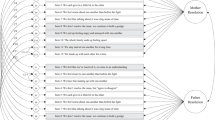Abstract
While research has demonstrated that interparental conflict is associated with poor child and adolescent functioning, studies have not yet addressed the characteristics of such conflict. The purpose of this study was twofold: (1) to report reliability and validity data of a questionnaire, the Interparental Conflict Questionnaire (ICQ), designed to assess the nature of interparental conflict more thoroughly than has been done previously, and (2) to compare the nature of such conflict in a married and divorced sample. Fifty-five married and 46 divorced parents, all of whom had a young adolescent, participated by completing two questionnaires: the O'Leary-Porter Scale and the ICQ. Validity (e.g., correlation with the O'Leary-Porter Scale) was generally acceptable for the ICQ, whereas test-retest reliability tended to be moderate to low. Additional findings indicated that heated arguments rarely occurred. Furthermore, in comparing married and divorced parents, the former discussed issues more and, to some extent, the latter argued more. However, one of the most striking aspects of the findings was the similarity of the married and divorced samples in terms of their conflict. Implications of the findings for understanding and explaining the role of interparental conflict in child and adolescent functioning are explored.
Similar content being viewed by others
References
Ahrons, C. R. (1983). Predictors of paternal involvement postdivorce: Mothers' and fathers' perceptions.Journal of Divorce, 6, 55–69.
Atkeson, B. M., Forehand, R. L., & Rickard, K. M. (1982). The effects of divorce on children. In B. B. Lahey & A. E. Kazdin (Eds.),Advances in clinical child psychology (Vol. 5, pp. 255–281). New York: Plenum Press.
Cummings, E. M., & Cummings, J. L. (in press). A process-oriented approach to children's coping with adults' angry behavior.Developmental Review.
Emery, R. E. (1982). Interparental conflict and the children of discord and divorce.Psychology Bulletin, 92, 310–330.
Forehand, R., Fauber, R., Long, N., Brody, G., & Slotkin, J. (1987). Maternal depressive mood following divorce: An examination of predictors and adolescent adjustment from a stress model perspective. In J. P. Vincent (Ed.),Advances in family intervention assessment, and theory (Vol. 4, pp. 71–98). Greenwich, CT: JAI Press.
Forehand, R., McCombs, A., Long, N., Brody, G. H., & Fauber, R. (1988). Early adolescent adjustment to recent parental divorce: The role of interparental conflict and adolescent sex as mediating variables.Journal of Consulting and Clinical Psychology, 56, 624–627.
Long, N., & Forehand, R. (1987). The effects of parental divorce and marital conflict on children: An overview.Journal of Developmental and Behavioral Pediatrics, 8, 292–296.
Long, N., Forehand, R., Fauber, R., & Brody, G. H. (1987). Self-perceived and independently perceived competence of young adolescents as a function of parental marital conflict and recent divorce.Journal of Abnormal Child Psychology, 15, 154–27.
Long, N., Slater, E., Forehand, R., & Fauber, R. (1988). Continued high or reduced interparental conflict following divorce: Relationship to young adolescent adjustment.Journal of Consulting and Clinical Psychology, 56, 467–469.
Margolin, G. (1981). The reciprocal relationship between marital and child problems. In J. P. Vincent (Ed.),Advances in family intervention, assessment, and theory (Vol. 2, pp. 131–182). Greenwich, CT: JAI Press.
Myers, J. K., & Bean, L. J. (1968).A decade later: A follow-up of social class and mental illness. New York: Wiley.
Porter, B., & O'Leary, K. D. (1980). Marital discord and childhood behavior problems.Journal of Abnormal Child Psychology, 8, 287–295.
Shaw, D. S., & Emery, R. E. (1987). Parental conflict and other correlates of adjustment of school-age children whose parents have separated.Journal of Abnormal Child Psychology, 15, 269–281.
Simmons, R., Burgeson, R., Carlton-Ford, S., & Blyth, D. (1987). The impact of cumulative change in early adolescence.Child Development, 58, 1220–1234.
Spanier, G. B. (1976). Measuring dyadic adjustment: New scales for assessing the quality of marriage and similar dyads.Journal of Marriage and the Family, 38, 15–28.
Strauss, M. A. (1979). Measuring intrafamily conflict and violence: The conflict tactics (CT) Scales.Journal of Marriage and the Family, 41, 5–88.
Author information
Authors and Affiliations
Additional information
This study was supported, in part, by the William T. Grant Foundation and the University of Georgia's Institute for Behavioral Research.
Rights and permissions
About this article
Cite this article
Forehand, R., McCombs, A. The nature of interparental conflict of married and divorced parents: Implications for young adolescents. J Abnorm Child Psychol 17, 235–249 (1989). https://doi.org/10.1007/BF00913797
Revised:
Issue Date:
DOI: https://doi.org/10.1007/BF00913797




